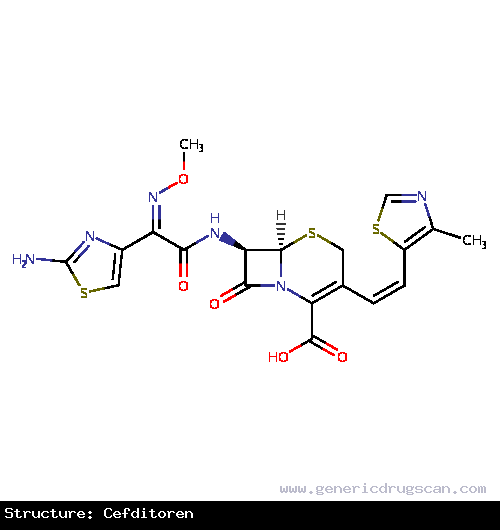Cefditoren Drug: Indication, Dosage, Precaution, Side Effect , Storage, Category Type and corresponding Brands - www.genericdrugscan.com
Cefditoren
Drug Status in USA : Approvedpronunciation
pronounced as (sef dit' or in)
Why is this medication prescribed?
Cefditoren is used to treat certain infections caused by bacteria such as bronchitis (infection of the airway tubes leading to the lungs); pneumonia; and infections of the skin, throat, and tonsils.Cefditoren is in a class of medications called cephalosporin antibiotics. It works by killing bacteria.
Antibiotics such as cefditoren will not work for colds, flu, or other viral infections. Using antibiotics when they are not needed increases your risk of getting an infection later that resists antibiotic treatment.
How should this medicine be used?
Cefditoren comes as a tablet to take by mouth. It is usually taken every 12 hours with the morning and evening meals for 10 to 14 days, depending on the condition being treated. Take cefditoren at around the same times every day. Follow the directions on your prescription label carefully, and ask your doctor or pharmacist to explain any part you do not understand. Take cefditoren exactly as directed. Do not take more or less of it or take it more often than prescribed by your doctor.
You should begin to feel better during your first few days of treatment with cefditoren. If your symptoms do not improve or get worse, call your doctor.
Take cefditoren until you finish the prescription, even if you feel better. If you stop taking cefditoren too soon or skip doses, your infection may not be completely cured and bacteria may become resistant to antibiotics.
What are the precautions to be followed?
Before taking cefditoren,- tell your doctor and pharmacist if you are allergic to cefditoren; other cephalosporin antibiotic such as cefaclor, cefadroxil cefazolin (Ancef, Kefzol), cefdinir, cefepime (Maxipime), cefixime (Suprax), cefotaxime (Claforan), cefotetan, cefoxitin (Mefoxin), cefpodoxime, cefprozil, ceftaroline (Teflaro), ceftazidime (Fortaz, Tazicef, in Avycaz), ceftibuten (Cedax), ceftriaxone (Rocephin), cefuroxime (Zinacef) and cephalexin (Keflex); penicillin antibiotics; or any other medications. Also tell your doctor if you are allergic to milk protein, or any of the other ingredients in cefditoren tablets. Ask your pharmacist for a list of the ingredients.
- tell your doctor and pharmacist what prescription and nonprescription medications, vitamins, nutritional supplements, and herbal products you are taking. Be sure to mention any of the following: antacids (Maalox, Mylanta, Tums, others); anticoagulants ('blood thinners') such as warfarin (Coumadin, Jantoven); medications that block stomach acid such as cimetidine , famotidine (Pepcid), nizatidine (Axid) and ranitidine (Zantac); medications that decrease stomach acid such as dexlansoprazole (Dexilant), esomeprazole (Nexium, in Vimvo), lansoprazole (Prevacid, in Prevpac), omeprazole (Prilosec, in Zegerid), pantoprazole (Protonix), and rabeprazole (Aciphex); or probenecid (Probalan). Your doctor may need to change the doses of your medications or monitor you carefully for side effects.
- tell your doctor if you have carnitine deficiency (a rare condition in which the body does not have enough of a certain substance that is needed for energy production). Your doctor will probably tell you not to take cefditoren.
- tell your doctor if you have or have ever had kidney or liver disease.
- tell your doctor if you are pregnant, plan to become pregnant, or are breastfeeding. If you become pregnant while taking cefditoren, call your doctor.
What are possible side effects of this medication ?
Cefditoren may cause side effects. Tell your doctor if any of these symptoms are severe or do not go away:- diarrhea
- nausea
- vomiting
- stomach pain
- heartburn
- headache
- swelling, redness, irritation, burning, or itching of the vagina
- white vaginal discharge
- watery or bloody stools, stomach cramps, or fever during treatment or for up to two or more months after stopping treatment
- hives
- rash
- itching
- difficulty breathing or swallowing
- closing of the throat
- a return of fever, sore throat, chills, or other signs of infection
Cefditoren may cause other side effects. Call your doctor if you have any unusual problems while taking this medication.
How to store the medication and dispose it of after its use later?
Keep this medication in the container it came in, tightly closed, and out of reach of children. Store it at room temperature and away from light and excess heat and moisture (not in the bathroom).
Unneeded medications should be disposed of in special ways to ensure that pets, children, and other people cannot consume them. However, you should not flush this medication down the toilet. Instead, the best way to dispose of your medication is through a medicine take-back program.
Drug Category/Class
- Anti-Bacterial Agents
- Cephalosporins
- Antibacterials for Systemic Use
- Third-Generation Cephalosporins
- Antiinfectives for Systemic Use
- Third-generation cephalosporins
| Prescribed | For the treatment of mild to moderate infections in adults and adolescents (12 years of age or older) which are caused by susceptible strains of mi... |
| Weight : | 506.578 |
| Structure | Cefditoren |
 | |
| Formula | C19H18N6O5S3 |
Cefditoren has 7 Brands listed
| Cefdicare (200 mg) | Cefditran (200 mg) |
| Cefforen (200 mg) | Ceftorin (200 mg) |
| Spectoren (200 mg) | Taxitorin (200 mg) |
| Torocef O (200 mg) |
Search Generic Drugs alphabetically
